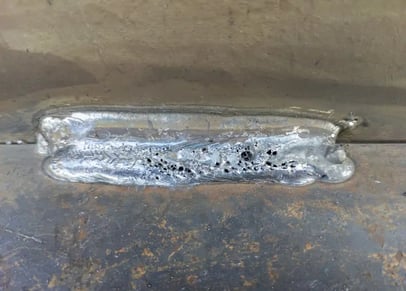Comprehensive Overview: What is Porosity in Welding and Just How to stop It
Comprehensive Overview: What is Porosity in Welding and Just How to stop It
Blog Article
Unraveling the Secret of Porosity in Welding: Tips for Minimizing Flaws and Optimizing Quality
In the intricate globe of welding, porosity stays a consistent challenge that can dramatically influence the quality and integrity of welded joints. As we delve into the depths of porosity in welding, uncovering the secrets to its prevention and control will be critical for professionals seeking to master the art of top quality weldments.
Understanding Porosity in Welding
Porosity in welding, a common issue encountered by welders, refers to the presence of gas pockets or gaps in the bonded product, which can jeopardize the stability and high quality of the weld. These gas pockets are usually caught during the welding procedure as a result of numerous aspects such as incorrect shielding gas, contaminated base products, or incorrect welding parameters. The development of porosity can damage the weld, making it susceptible to cracking and corrosion, eventually resulting in structural failings.
By identifying the significance of preserving proper gas shielding, making sure the sanitation of base materials, and enhancing welding setups, welders can dramatically decrease the probability of porosity formation. In general, an extensive understanding of porosity in welding is vital for welders to produce high-quality and long lasting welds.

Typical Causes of Porosity
When inspecting welding procedures for prospective high quality concerns, understanding the usual reasons of porosity is important for keeping weld integrity and preventing architectural failures. Porosity, defined by the presence of cavities or voids in the weld steel, can substantially jeopardize the mechanical residential properties of a bonded joint. One common reason for porosity is improper securing gas protection. Poor securing gas flow prices or inappropriate gas blends can lead to climatic contamination, leading to porosity formation.
An additional common reason for porosity is the presence of dampness and impurities externally of the base steel or filler material. When welding materials are not correctly cleaned up or are exposed to high degrees of moisture, the evaporation of these pollutants during welding can produce voids within the weld grain. In addition, welding at inappropriate specifications, such as exceedingly high traveling speeds or currents, can produce extreme turbulence in the weld pool, capturing gases and triggering porosity. By addressing these typical reasons through proper gas shielding, product preparation, and adherence to optimum welding criteria, welders can decrease porosity and boost the quality of their welds.
Techniques for Porosity Avoidance
Executing efficient safety nets is essential in minimizing the occurrence of porosity in welding processes. One method for porosity avoidance is ensuring correct cleaning of the base steel before welding. Pollutants such as oil, oil, rust, and paint can lead to porosity, so thorough cleansing using appropriate solvents or mechanical approaches is essential.

Making use of high-quality filler materials and shielding gases that are appropriate for the base metal and welding procedure can substantially lower helpful resources the risk of porosity. Furthermore, keeping proper welding specifications, such as voltage, current, travel rate, and gas flow rate, is vital for porosity avoidance.
Moreover, utilizing proper welding methods, such as preserving a constant travel speed, electrode angle, and arc length, can help avoid porosity (What is Porosity). Appropriate training of welders to guarantee they adhere to finest techniques and quality control treatments is additionally crucial in lessening porosity flaws in welding

Ideal Practices for High Quality Welds
One secret practice is preserving proper tidiness in the welding area. Thoroughly cleaning the work surface and surrounding location before welding can assist mitigate these concerns.
An additional finest technique is to meticulously pick the ideal welding parameters for the particular materials being joined. This consists of establishing the appropriate voltage, current, travel rate, and protecting gas circulation rate. Proper parameter choice makes certain optimal weld penetration, combination, and total high quality. In addition, using top notch welding consumables, such as electrodes and filler metals, can considerably affect the last weld quality. Purchasing costs consumables can result in stronger, extra resilient welds with less defects. By complying with these best methods, welders can regularly generate high-quality welds that fulfill market requirements and go beyond consumer assumptions.
Importance of Porosity Control
Porosity control plays an essential role in making sure the stability and top quality of welding joints. Porosity, identified by the existence of tooth cavities or gaps within the weld steel, can significantly jeopardize the mechanical residential or commercial properties and structural honesty of the weld. Extreme porosity compromises the weld, making it extra susceptible to breaking, rust, and overall failing under functional loads.
Reliable porosity control is necessary for maintaining the desired mechanical buildings, such as stamina, ductility, and sturdiness, of the welded joint. What is Porosity. By lessening porosity, welders can enhance the general top quality and reliability of the weld, making certain that it satisfies the performance demands of the designated application
Moreover, porosity control is essential for achieving the desired visual look of the weld. Too much porosity not just deteriorates the weld but also detracts from its aesthetic appeal, which can be important in sectors where visual appeals are very important. Appropriate porosity control strategies, such as making use of the right shielding gas, managing the welding specifications, and guaranteeing appropriate read review sanitation of the base materials, are necessary for creating top quality welds with very why not try these out little defects.

Verdict
In conclusion, porosity in welding is a common defect that can compromise the top quality of the weld. It is crucial to manage porosity in welding to make certain the integrity and stamina of the final item.
Report this page